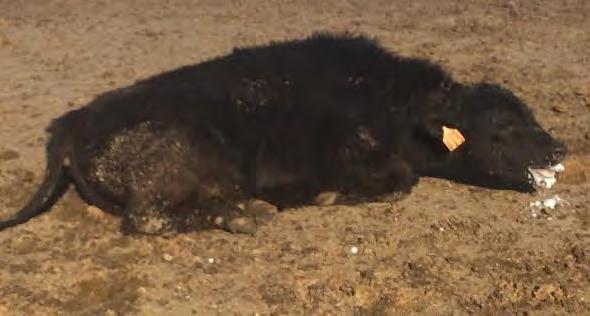
3 minute read
Bovine Respiratory Syncytial Virus in Cattle Bovine Respiratory Syncytial Virus in Cattle
By: Jose Valles, MS and Lisa Taylor, MS, Production Animal Consultation
By: Jose Valles, MS and Lisa Taylor, MS, Production Animal Consultation
Bovine respiratory syncytial virus (BRSV) is prevalent in cattle populations worldwide. It was first recognized as a pathogen in 1970 in Switzerland, and the first case of BRSV in the United States was recorded four years later. BRSV shares similarities with human respiratory syncytial virus (HRSV), but there is no evidence of cross-species infection. Similar respiratory syncytial viruses also affect sheep and goats.
Bovine respiratory syncytial virus (BRSV) is prevalent in cattle populations worldwide. It was first recognized as a pathogen in 1970 in Switzerland, and the first case of BRSV in the United States was recorded four years later. BRSV shares similarities with human respiratory syncytial virus (HRSV), but there is no evidence of cross-species infection. Similar respiratory syncytial viruses also affect sheep and goats.
BRSV is a viral component of the bovine respiratory disease (BRD) complex and is one of the primary BRD pathogens. This ribonucleic acid virus is categorized as a pneumovirus and belongs to the Paramyxovirus family.
BRSV is a viral component of the bovine respiratory disease (BRD) complex and is one of the primary BRD pathogens. This ribonucleic acid virus is categorized as a pneumovirus and belongs to the Paramyxovirus family.
The virus has a cytopathic effect, creating syncytial cells in the mucosal lining of the respiratory tract. BRSV tends to affect the lower respiratory tract, and infection with BRSV increases susceptibility to viral and secondary bacterial infections.
The virus has a cytopathic effect, creating syncytial cells in the mucosal lining of the respiratory tract. BRSV tends to affect the lower respiratory tract, and infection with BRSV increases susceptibility to viral and secondary bacterial infections.
The virus can be transmitted by direct contact with respiratory secretions of infected animals or by inhalation of aerosolized respiratory secretions.
The virus can be transmitted by direct contact with respiratory secretions of infected animals or by inhalation of aerosolized respiratory secretions.
Severe clinical cases of BRSV are most common in beef and dairy animals up to 6 months of age. Typically, beef cattle between 6 weeks and 13 months old and dairy cattle between 2 weeks and 9 months old are most prone to infection. Experts believe that passive immunity from maternal antibodies and active immunity from previous exposure help decrease the severity of respiratory disease associated with BRSV but do not prevent infection.
Reinfection with the virus is possible. While the first exposure to BRSV usually results in acute disease, subsequent exposure is often associated with subclinical or mild respiratory disease. Outbreaks most often occur during the fall and winter and are commonly caused by stress-inducing factors such as diet changes, transportation, overcrowding, weaning, and weather changes. Case fatality rates in BRSV outbreaks can be as high as 20 percent.
Severe clinical cases of BRSV are most common in beef and dairy animals up to 6 months of age. Typically, beef cattle between 6 weeks and 13 months old and dairy cattle between 2 weeks and 9 months old are most prone to infection. Experts believe that passive immunity from maternal antibodies and active immunity from previous exposure help decrease the severity of respiratory disease associated with BRSV but do not prevent infection.

Reinfection with the virus is possible. While the first exposure to BRSV usually results in acute disease, subsequent exposure is often associated with subclinical or mild respiratory disease. Outbreaks most often occur during the fall and winter and are commonly caused by stress-inducing factors such as diet changes, transportation, overcrowding, weaning, and weather changes. Case fatality rates in BRSV outbreaks can be as high as 20 percent.
Animals suspected of BRSV infection must be examined in a timely manner. Examination should take into account rectal temperature, lung score, visual clinical signs, movement, and feed and water consumption. Evaluation should be performed without compromising the health of the animal.
Animals suspected of BRSV infection must be examined in a timely manner. Examination should take into account rectal temperature, lung score, visual clinical signs, movement, and feed and water consumption. Evaluation should be performed without compromising the health of the animal.
Clinical signs of BRSV can vary in severity and may include cough, depression, decreased appetite, decreased milk production, dehydration, difficulty breathing, fever, frothy mouth, grunting, increased respiration rate, lowered head and extended neck, nasal discharge, ocular discharge, open -mouth breathing, reluctance to movement, and subcutaneous emphysema (Figure 1).
Clinical signs of BRSV can vary in severity and may include cough, depression, decreased appetite, decreased milk production, dehydration, difficulty breathing, fever, frothy mouth, grunting, increased respiration rate, lowered head and extended neck, nasal discharge, ocular discharge, open-mouth breathing, reluctance to movement, and subcutaneous emphysema (Figure 1).
Animals typically begin expressing clinical signs 3 to 5 days after BRSV exposure and may continue showing clinical signs for 1 to 2 weeks thereafter.
Necropsy of suspected BRSV mortalities is encouraged. Because BRSV infection is commonly followed by secondary bacterial infection, gross lesions may vary. Common visible lesions in BRSV-infected animals may include diffuse interstitial pneumonia; interstitial edema (usually in the caudal lobes), interstitial and sub-pleural emphysema, alveolitis, and adenomatosis (Figures 2, 3).
Animals typically begin expressing clinical signs 3 to 5 days after BRSV exposure and may continue showing clinical signs for 1 to 2 weeks thereafter. Necropsy of suspected BRSV mortalities is encouraged. Because BRSV infection is commonly followed by secondary bacterial infection, gross lesions may vary. Common visible lesions in BRSV-infected animals may include diffuse interstitial pneumonia; interstitial edema (usually in the caudal lobes), interstitial and sub-pleural emphysema, alveolitis, and adenomatosis (Figures 2, 3).










